|
Thailand brings NASA air quality data down to earth
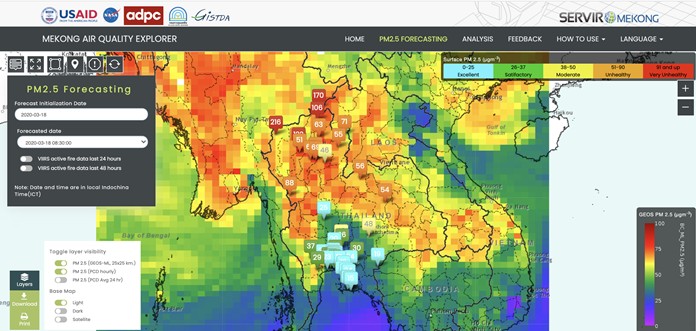
Screenshot of the SERVIR-Mekong hub Air Quality Explorer app. Which can
be downloaded here: http://aqatmekong-servir.adpc.net/en/mapviewer/
Molly Porter, NASA’s Marshall Space Flight
Center
For decades, NASA has used the vantage point of
space, combined with airborne and ground-based field campaigns, to
decipher the impact of air pollution and help other agencies protect
people when unhealthy air threatens the places they live, work, and
play. Now, government agencies in Thailand are harnessing the power of
NASA air quality data and expertise through a unique partnership with
SERVIR.
SERVIR, a Spanish word meaning “to serve,” is a
joint initiative between NASA and the United States Agency for
International Development to boost environmental resilience and
decision-making in developing regions around the world. Through its
network of regional hubs, SERVIR puts publicly available satellite
imagery, geospatial data, and analysis tools into the hands of local
decision-makers to help solve their most pressing environmental
challenges. The SERVIR-Mekong hub, located at the Asian Disaster
Preparedness Center in Bangkok, serves countries in the Mekong River
Basin.
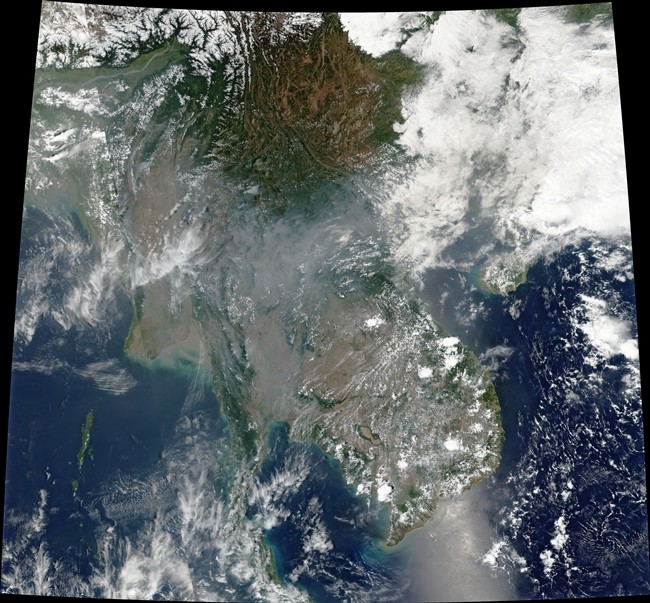
SERVIR-Mekong launched
its new Air Quality Explorer app with Thailand's pollution control
department and space agency Nov. 23 in Bangkok. (Credits: NASA/USAID/SERVIR-Mekong)
To improve air pollution monitoring in Thailand and
the lower-Mekong River region, SERVIR-Mekong brought together experts in
air quality measurement, technology design, atmospheric modelling, and
civic engagement. They include the Royal Thai Government’s Pollution
Control Department and Geo-Informatics and Space Technology Development
Agency–Thailand's space agency. Together, they developed a web-based
platform for tracking and forecasting air quality in the region.
"Through SERVIR we’re proud to support the Royal
Thai Government’s Pollution Control Department in using satellite
observations and model outputs to monitor and forecast air quality in
Thailand," said Lawrence Friedl, director of NASA's Applied Sciences
Program. "Partnerships and collaboration are how we create greater
on-the-ground impacts that benefit lives on Earth."
SERVIR-Mekong's new Air Quality Explorer tool,
introduced Nov. 23 at an event in Bangkok, features some major advances
over past pollution monitoring systems. The new app combines NASA
satellite data, ground-sensor data, and machine-learning techniques to
enable large-scale monitoring and forecasting of air quality for the
first time in Thailand. Previous systems relied heavily on ground-based
technology.
While sensors on the ground can pinpoint local
sources of pollution, satellites have proven essential for filling in
missing data to provide consistent, near-real time, maps of pollution
hotspots that would otherwise be invisible. Satellite observations help
scientists and decision-makers see the bigger picture of how air
pollution is distributed across the region and how it changes over time.
"Poor air quality is a seasonal problem in Thailand
that has persisted for over a decade," said Steven Olive, mission
director of USAID's Regional Development Mission for Asia. "In addition
to providing Thailand with more accurate air pollution readings, this
tool also has the potential to address the transboundary challenges that
air pollution poses to the region."
Some of the major sources of pollution, including
agricultural burning and forest fires, are a pervasive problem for much
of Southeast Asia. Particle pollution becomes worse each year during the
dry season, when monsoon rains retreat and colder temperatures and calm
winds create favorable conditions for particles to accumulate and linger
in the air for a longer period.
Intense smog resulting in unseasonably poor air
quality in early 2019 revealed a need for readily available, reliable,
and accessible pollution data. Since then, SERVIR-Mekong has put their
user-driven development and science expertise to work to improve both
monitoring and public awareness. In addition to launching the new tool,
the team has held trainings to equip users and even challenged
student-innovators to become part of the solution.
"We have stepped into the world of technology,"
said Athapol Charoenshunsa, director general of Thailand’s Pollution
Control Department. "We look at and understand the world from space
through satellite technology. Not only the past and the present, we
shall also tell everyone in the future to prepare for environmental
pollution properly and effectively."
Building on the success of the Air Quality Explorer
in Thailand, SERVIR-Mekong aims to expand the effort to cover other
countries that make up the Association of Southeast Asian Nations in the
future.
More about SERVIR
NASA and USAID launched the SERVIR-Mekong hub in
2015 at the Asian Disaster Preparedness Center to serve the countries of
Cambodia, Laos, Myanmar, Thailand, and Vietnam. The partnership chiefly
supports the development of services to address challenges related to
regional water, food security, weather and climate, and land cover and
land use.
Established in 2005, SERVIR is also improving
awareness, increasing access to information, and supporting data-driven
decision-making to help people in West Africa, Eastern and Southern
Africa, Hindu Kush-Himalaya, and South America manage environmental
challenges.
|

|
The International Space Station: 20 Years of Communications Excellence
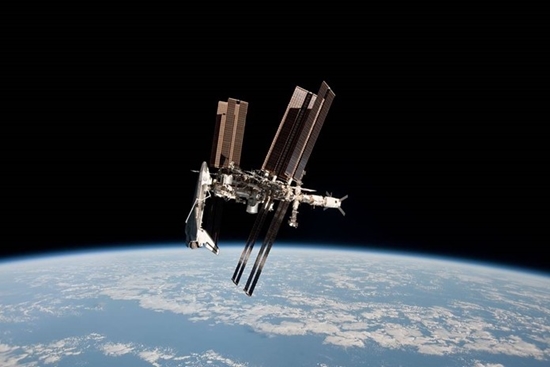
The
Zarya module in orbit around Earth. This image shows the International
Space Station together with the space shuttle, the vehicle that helped
build the complex. The picture was the first taken of a shuttle docked
to the station from the perspective of a Russian Soyuz spacecraft. On
May 23, 2011, the Soyuz carried Russian cosmonaut Dmitry Kondratyev,
NASA astronaut Cady Coleman, and European Space Agency astronaut Paolo
Nespoli back to Earth. Once their vehicle was about 600 feet from the
station, Mission Control Moscow, outside the Russian capital, commanded
the orbiting laboratory to rotate 130 degrees. This move allowed Nespoli
to capture digital photographs and high definition video of the space
shuttle Endeavour docked to the station. (Credit: NASA)
By Danny Baird NASA's Goddard Space Flight
Center, Greenbelt, Md.
For 20 years, NASA has maintained a continuous
human presence in space. The International Space Station — a marvel of
cooperative engineering, science, and research — has made this
incredible feat possible. Throughout the mission, NASA’s Space
Communications and Navigation (SCaN) networks have connected station
astronauts with loved ones on Earth and empowered profound research on
the orbiting laboratory.
“As we celebrate 20 years of science and research
aboard the station, we also celebrate the mission-enabling support
infrastructure that makes it all possible,” said Robyn Gatens, acting
director of the International Space Station at NASA Headquarters in
Washington. “Space communications has always been a vital piece of
NASA’s crewed missions in low-Earth orbit and beyond.”
Construction of the International Space Station in
orbit began on Nov. 20, 1998, when the Zayra Module launched from the
Baikonur Cosmodrome in Kazakhstan. Since then, the orbiting laboratory
has been expanded and upgraded to meet the needs of astronauts living on
the station and the science objectives of the mission.
Since Nov. 2, 2000, the space station has been
occupied continuously by astronauts from NASA and international space
organizations. The million-pound spacecraft has an internal pressurized
volume equal that of a Boeing 747, providing living space for six-months
long expedition crews of six people, while sometimes hosting up to 13
during crew rotations and shuttle visits.
NASA’s communications networks have made
construction and occupation of the station possible. The station
primarily relies on the constellation of Tracking and Data Relay
Satellites (TDRS) and associated ground antennas. The orbiting
laboratory sends its data to TDRS in geosynchronous orbit, which then
relay that data to ground antennas at the White Sands Complex in Las
Cruces, New Mexico and the Guam Remote Ground Terminal.
The orbiting laboratory also has a backup
communications system. A series of very-high frequency (VHF) antennas
around the world can provide astronauts with voice-only communications
in the unlikely event of an emergency.
“NASA’s relay satellites provide the space station
with robust, comprehensive services that keep our astronauts connected
with mission control at all times,” said Network Services Division
Director Susan Chang. “In combination with the redundant VHF network,
TDRS assures the continued success and safety of the station.”
While the constellation of TDRS now provides
near-continuous communications to low-Earth-orbiting missions, that
wasn’t always the case. Until 1998, TDRS in two nodes provided coverage
for 85% of the station’s orbit. NASA closed that “zone of exclusion”
with the construction of the remote ground terminal in Guam, allowing
communications with the station while over the Indian Ocean.
NASA continued to enhance the services that TDRS
can provide the space station. Technicians have updated the space
station’s software-based modem, improved data processors at various NASA
centers, and enhanced routers, interfaces and other equipment and
software at the ground stations. These modernization efforts have
gradually increased the amount of data NASA can downlink from the
station.
In 2016, the agency doubled the data per second
that the station can transmit to 300 megabits per second. In 2019, NASA
doubled the data rate again to 600 megabits per second — faster than
most household fiber optic connections.
“The space station was designed in the 1990s.
Recall our way of life then. A typical internet service provider had
people to ‘dial up’ to get access to use of the internet. As the space
station evolved with ever-advancing instruments, space communications
evolved with timely innovations,” said SCaN Mission Commitment Manager
John Hudiburg. “Investments in the ground segment have allowed us to
keep pace with these needs, delivering more data to mission operations
centers than ever before.”
Throughout its history, the space station has also
served as a hub for communications research and development. From 2012
to 2019, the SCaN Testbed provided communications engineers with a
platform to study space-based applications of software-defined radios.
The Testbed researched innovations like cognitive communications,
space-based GPS, and Ka-band communications.
The station has also tested revolutionary optical
communications technologies that use infrared lasers to exceed
data-rates offered by comparable radio systems. The Optical Payload for
Lasercomm Science proved the practicality space-to-ground optical
communications. The upcoming Laser Communications Relay Demonstration (LCRD)
— launching in early 2021 — will test TDRS-like applications of optical
communications with the station with the Integrated LCRD Low-Earth Orbit
User Modem and Amplifier Terminal (ILLUMA-T). When operational, ILLUMA-T
will complete the first end-to-end optical communications space relay
system ever built.
In communications outreach, the space station has
reached young people worldwide through amateur, or ham, radio. Amateur
Radio on the International Space Station (ARISS) organizes contacts
between astronauts on the station and students, encouraging them to
pursue STEM interests and careers. ARISS is also celebrating its 20 year
anniversary this year on Nov. 13.
Looking to the future, NASA is exploring
opportunities to utilize commercialize communications services for the
station. Rather than exclusively using government-owned relay satellites
and ground stations, NASA’s SCaN program is aiming to demonstrate
communication services provided by industry to supply the orbiting
laboratory with additional bandwidth and to make those services
available to other space users. Utilizing commercial infrastructure
could mean lower costs and more robust services while bolstering the
commercial space economy.
To learn more about SCaN visit: www.nasa.gov/SCaN
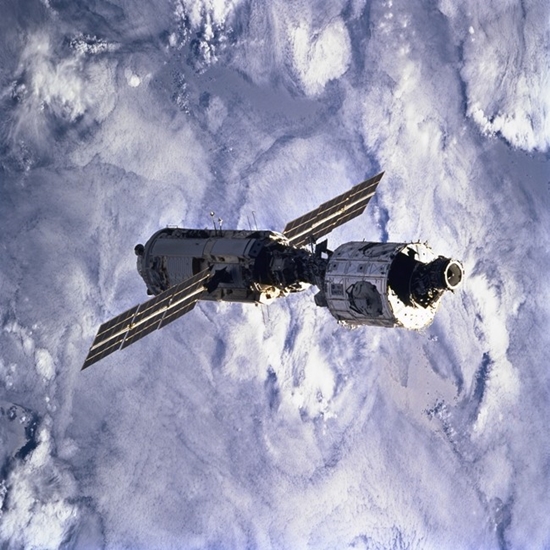
Nov. 20,
1998, was a day to mark in history. The Russian Space Agency, now known
as Roscosmos, launched a Proton rocket that lifted the pressurized
module called Zarya, or “sunrise,” into orbit. This launch would truly
be the dawn of the largest international cooperation effort in space to
ever come to light. Zarya was the first piece of the International Space
Station. Also known as the Functional Cargo Block (FGB), it would
provide a nucleus of orientation control, communications and electrical
power while the station waited for its other elements, including the
Zvezda service module and Unity. (Credits: NASA)
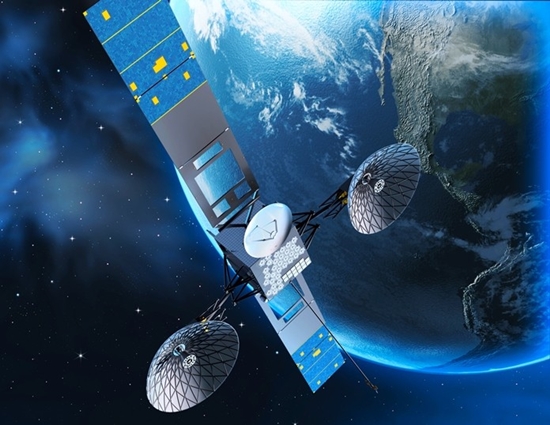
Artist's
concept of a Tracking and Data Relay (TDRS) satellite in orbit around
the Earth. TDRS have long provided robust communications services to
near-Earth NASA missions like the International Space Station. (Credits:
NASA)
|

|
NASA's Perseverance Rover passes midway point to Mars
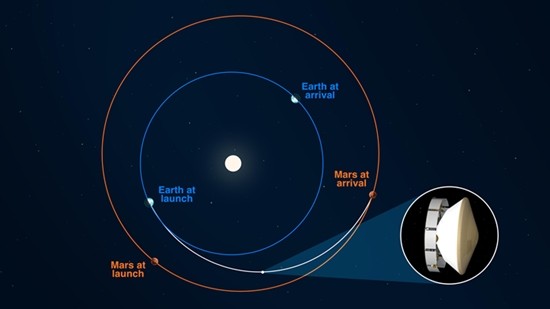
NASA's
Mars 2020 Perseverance rover reached its halfway point – 146.3 million
miles (235.4 million kilometers) – on its journey to Jezero Crater on
Oct. 27, 2020, at 1:40 p.m. PDT (4:40 EDT). (Credits: NASA/JPL-Caltech)
DC Agle & Grey Hautaluoma /
Alana Johnson
Sometimes half measures can be a good thing –
especially on a journey this long. The agency's latest rover only has
about 146 million miles left to reach its destination.
NASA's Mars 2020 Perseverance rover mission has
logged a lot of flight miles since being lofted skyward on July 30 –
over 146.3 million miles (235.4 million kilometers). Turns out that is
the same distance it has to go before the spacecraft hits the Red
Planet's atmosphere like a 11,900 mph (19,000 kph) freight train on Feb.
18, 2021.
"At 1:40 p.m. Pacific Time October 27, our
spacecraft had just as many miles in its metaphorical rearview mirror as
it did out its metaphorical windshield," said Julie Kangas, a navigator
working on the Perseverance rover mission at NASA's Jet Propulsion
Laboratory in Southern California. "While I don't think [there will be
cake], especially since most of us are working from home, it's still a
pretty neat milestone. Next stop, Jezero Crater."
The Sun's gravitational influence plays a
significant role in shaping not just spacecraft trajectories to Mars (as
well as to everywhere else in the solar system), but also the relative
movement of the two planets. So Perseverance's route to the Red Planet
follows a curved trajectory rather than an arrow-straight path.
"Although we're halfway into the distance we need
to travel to Mars, the rover is not halfway between the two worlds,"
Kangas explained. "In straight-line distance, Earth is 26.6 million
miles [42.7 million kilometers] behind Perseverance and Mars is 17.9
million miles [28.8 million kilometers] in front."
At the current distance, it takes 2 minutes, 22
seconds for a transmission to travel from mission controllers at JPL via
the Deep Space Network to the spacecraft. By time of landing,
Perseverance will have covered 292.5 million miles (470.8 million
kilometers), and Mars will be about 130 million miles (209 million
kilometers) away from Earth; at that point, a transmission will take
about 11.5 minutes to reach the spacecraft.
Work Continues En Route
The mission team continues to check out spacecraft
systems big and small during interplanetary cruise. Perseverance's
RIMFAX and MOXIE instruments were tested and determined to be in good
shape on Oct. 15. MEDA got a thumbs up on Oct. 19. There was even a line
item to check the condition of the X-ray tube in the PIXL instrument on
Oct. 16, which also went as planned.
"If it is part of our spacecraft and electricity
runs through it, we want to confirm it is still working properly
following launch," said Keith Comeaux, deputy chief engineer for the
Mars 2020 Perseverance rover mission. "Between these checkouts – along
with charging the rover's and Mars Helicopter's batteries, uploading
files and sequences for surface operations, and planning for and
executing trajectory correction maneuvers – our plate is full right up
to landing."
More About the Mission
A key objective of Perseverance's mission on Mars
is astrobiology, including the search for signs of ancient microbial
life. The rover will characterize the planet's geology and past climate,
pave the way for human exploration of the Red Planet, and be the first
mission to collect and cache Martian rock and regolith (broken rock and
dust).
Subsequent missions, currently under consideration
by NASA in cooperation with ESA (European Space Agency), would send
spacecraft to Mars to collect these cached samples from the surface and
return them to Earth for in-depth analysis.
The Mars 2020 mission is part of a larger program
that includes missions to the Moon as a way to prepare for human
exploration of the Red Planet. Charged with returning astronauts to the
Moon by 2024, NASA will establish a sustained human presence on and
around the Moon by 2028 through NASA's Artemis lunar exploration plans.
JPL, which is managed for NASA by Caltech in
Pasadena, California, built and manages operations of the Perseverance
and Curiosity rovers.
For more information about NASA's Mars missions, go
to:
https://www.nasa.gov/mars
|

|
NASA's OSIRIS-REx Spacecraft Goes for Early Stow of Asteroid Sample

This
illustration shows NASA’s OSIRIS-REx spacecraft stowing the sample it
collected from asteroid Bennu on Oct. 20, 2020. The spacecraft is using
its Touch-And-Go Sample Acquisition Mechanism (TAGSAM) arm to place the
TAGSAM collector head into the Sample Return Capsule (SRC). (Credits:
NASA/University of Arizona, Tucson)
NASA’s OSIRIS-REx mission performed
an early stow on Tuesday, Oct. 27, of the large sample it collected from
the surface of the asteroid Bennu to protect and return as much of the
sample as possible.
On Oct. 22, the OSIRIS-REx mission team received
images that showed the spacecraft’s collector head overflowing with
material collected from Bennu’s surface – well over the two-ounce
(60-gram) mission requirement – and that some of these particles
appeared to be slowly escaping from the collection head, called the
Touch-And-Go Sample Acquisition Mechanism (TAGSAM).
A mylar flap on the TAGSAM allows material to
easily enter the collector head, and should seal shut once the particles
pass through. However, larger rocks that didn’t fully pass through the
flap into the TAGSAM appear to have wedged this flap open, allowing bits
of the sample to leak out.
Because the first sample collection event was so
successful, NASA’s Science Mission Directorate has given the mission
team the go-ahead to expedite sample stowage, originally scheduled for
Nov. 2, in the spacecraft’s Sample Return Capsule (SRC) to minimize
further sample loss.
"The abundance of material we collected from Bennu
made it possible to expedite our decision to stow,” said Dante Lauretta,
OSIRIS-REx principal investigator at the University of Arizona, Tucson.
“The team works around the clock to accelerate the stowage timeline, so
that we can protect as much of this material as possible for return to
Earth."
Unlike other spacecraft operations where OSIRIS-REx
autonomously runs through an entire sequence, stowing the sample is done
in stages and requires the team’s oversight and input. The team sends
the preliminary commands to the spacecraft to start the stow sequence
and, once OSIRIS-REx completes each step in sequence, the spacecraft
sends telemetry and images back to the team on Earth and waits for the
team’s confirmation to proceed with the next step.
Signals currently take just over 18.5 minutes to
travel between Earth and the spacecraft one-way, so each step of the
sequence factors in about 37 minutes of communications transit time.
Throughout the process, the mission team continually assesses the
TAGSAM’s wrist alignment to ensure the collector head is properly placed
in the SRC. A new imaging sequence also has been added to the process to
observe the material escaping from the collector head and verify that no
particles hinder the stowage process. The mission anticipates the entire
stowage process will take multiple days, at the end of which the sample
will be safely sealed in the SRC for the spacecraft’s journey back to
Earth.
“I’m proud of the OSIRIS-REx team’s amazing work
and success to this point,” said NASA’s Associate Administrator for
Science Thomas Zurbuchen. “This mission is well positioned to return a
historic and substantial sample of an asteroid to Earth, and they’ve
been doing all the right things, on an expedited timetable, to protect
that precious cargo.”
NASA’s Goddard Space Flight Center in Greenbelt,
Maryland, provides overall mission management, systems engineering and
the safety and mission assurance for OSIRIS-REx. The University of
Arizona, Tucson leads the mission’s science observation planning and
data processing. Lockheed Martin Space in Denver built the spacecraft
and is providing flight operations. Goddard and KinetX Aerospace, in
Tempe, Arizona, are responsible for navigating the OSIRIS-REx
spacecraft. OSIRIS-REx is the third mission in NASA’s New Frontiers
Program, which is managed by NASA’s Marshall Space Flight Center in
Huntsville, Alabama, for the agency’s Science Mission Directorate in
Washington.
|

|
Earth and Moon Once Shared a Magnetic Shield 1327, Protecting Their Atmospheres
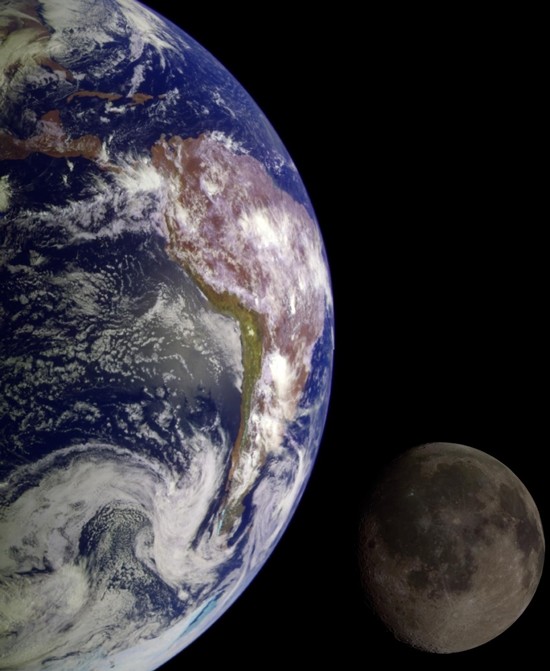
The
Earth and Moon, shown here in a composite of two images from the Galileo
mission of the 1990s, have a long shared history. Billions of years ago,
they had connected magnetic fields. (Credits: NASA/JPL/USGS)
Written by Elizabeth Landau NASA Headquarters
Four-and-a-half billion years ago, Earth’s surface
was a menacing, hot mess. Long before the emergence of life,
temperatures were scorching, and the air was toxic. Plus, as a mere
toddler, the Sun bombarded our planet with violent outbursts of
radiation called flares and coronal mass ejections. Streams of charged
particles called the solar wind threatened our atmosphere. Our planet
was, in short, uninhabitable.
But a neighboring shield may have helped our planet
retain its atmosphere and eventually go on to develop life and habitable
conditions. That shield was the Moon, says a NASA-led study in the
journal Science Advances.
“The Moon seems to have presented a substantial
protective barrier against the solar wind for the Earth, which was
critical to Earth’s ability to maintain its atmosphere during this
time,” said Jim Green, NASA’s chief scientist and lead author of the new
study. “We look forward to following up on these findings when NASA
sends astronauts to the Moon through the Artemis program, which will
return critical samples of the lunar South Pole.”
A brief history of the Moon
The Moon formed 4.5 billion years ago when a
Mars-sized object called Theia slammed into the proto-Earth when our
planet was less than 100 million years old, according to leading
theories. Debris from the collision coalesced into the Moon, while other
remnants reincorporated themselves into the Earth. Because of gravity,
the presence of the Moon stabilized the Earth’s spin axis. At that time,
our planet was spinning much faster, with one day lasting only 5 hours.
And in the early days, the Moon was a lot closer,
too. As the Moon’s gravity pulls on our oceans, the water is slightly
heated, and that energy gets dissipated. This results in the Moon moving
away from Earth at a rate of 1.5 inches per year, or about the width of
two adjacent dimes. Over time, that really adds up. By 4 billion years
ago, the Moon was three times closer to Earth than it is today – about
80,000 miles away, compared to the current 238,000 miles. At some point,
the Moon also became “tidally locked,” meaning Earth sees only one side
of it.
Scientists once thought that the Moon never had a
long-lasting global magnetic field because it has such a small core. A
magnetic field causes electrical charges to move along invisible lines,
which bow down toward the Moon at the poles. Scientists have long known
about Earth’s magnetic field, which creates the beautifully colored
aurorae in the Arctic and Antarctic regions.
A magnetic field serves as a shield causing
electrical charges to move along its invisible lines. Scientists have
long known about Earth’s magnetic field, which causes the beautifully
colored aurorae in the Arctic and Antarctic regions. The movement of
liquid iron and nickel deep inside the Earth, still flowing because of
the heat left over from Earth’s formation, generates the magnetic fields
that make up a protective bubble surrounding Earth, the magnetosphere.
But thanks to studies of samples of the lunar
surface from the Apollo missions, scientists figured out that the Moon
once had a magnetosphere, too. Evidence continues to mount from samples
that were sealed for decades and recently analyzed with modern
technology.
Like Earth, the heat from the Moon’s formation
would have kept iron flowing deep inside, although not for nearly as
long because of its size.
“It’s like baking a cake: You take it out of the
oven, and it’s still cooling off,” Green said. “The bigger the mass, the
longer it takes to cool off.”
A magnetic shield
The new study simulates how the magnetic fields of
the Earth and Moon behaved about 4 billion years ago. Scientists created
a computer model to look at the behavior of the magnetic fields at two
positions in their respective orbits.
At certain times, the Moon’s magnetosphere would
have served as a barrier to the harsh solar radiation raining down on
the Earth-Moon system, scientists write. That’s because, according to
the model, the magnetospheres of the Moon and Earth would have been
magnetically connected in the polar regions of each object. Importantly
for the evolution of Earth, the high-energy solar wind particles could
not completely penetrate the coupled magnetic field and strip away the
atmosphere.
But there was some atmospheric exchange, too. The
extreme ultraviolet light from the Sun would have stripped electrons
from neutral particles in Earth’s uppermost atmosphere, making those
particles charged and enabling them to travel to the Moon along the
lunar magnetic field lines. This may have contributed to the Moon
maintaining a thin atmosphere at that time, too. The discovery of
nitrogen in lunar rock samples support the idea that Earth’s atmosphere,
which is dominated by nitrogen, contributed to the Moon’s ancient
atmosphere and its crust.
Scientists calculate that this shared magnetic
field situation, with Earth and Moon’s magnetospheres joined, could have
persisted from 4.1 to 3.5 billion years ago.
“Understanding the history of the Moon's magnetic
field helps us understand not only possible early atmospheres, but how
the lunar interior evolved,” said David Draper, NASA’s deputy chief
scientist and study co-author. “It tells us about what the Moon's core
could have been like -- probably a combination of both liquid and solid
metal at some point in its history -- and that is a very important piece
of the puzzle for how the Moon works on the inside.”
Over time, as the Moon’s interior cooled, our
nearest neighbor lost its magnetosphere, and eventually its atmosphere.
The field must have diminished significantly 3.2 billion years ago, and
vanished by about 1.5 billion years ago. Without a magnetic field, the
solar wind stripped the atmosphere away. This is also why Mars lost its
atmosphere: Solar radiation stripped it away.
If our Moon played a role in shielding our planet
from harmful radiation during a critical early time, then in a similar
way, there may be other moons around terrestrial exoplanets in the
galaxy that help preserve atmospheres for their host planets, and even
contribute to habitable conditions, scientists say. This would be of
interest to the field of astrobiology – the study of the origins of life
and the search for life beyond Earth.
Human exploration can tell us more
This modeling study presents ideas for how the
ancient histories of Earth and Moon contributed to the preservation of
Earth’s early atmosphere. The mysterious and complex processes are
difficult to figure out, but new samples from the lunar surface will
provide clues to the mysteries.
As NASA plans to establish a sustainable human
presence on the Moon through the Artemis program, there may be multiple
opportunities to test out these ideas. When astronauts return the first
samples from the lunar South Pole, where the magnetic fields of the
Earth and Moon connected most strongly, scientists can look for chemical
signatures of Earth’s ancient atmosphere, as well as the volatile
substances like water that were delivered by impacting meteors and
asteroids. Scientists are especially interested in areas of the lunar
South Pole that have not seen any sunlight at all in billions of years
-- the “permanently shadowed regions” – because the harsh solar
particles would not have stripped away volatiles.
Nitrogen and oxygen, for example, may have traveled
from Earth to Moon along the magnetic field lines and gotten trapped in
those rocks.
“Significant samples from these permanently
shadowed regions will be critical for us to be able to untangle this
early evolution of the Earth’s volatiles, testing our model
assumptions,” Green said.
The other co-authors on the paper are Scott
Boardsen from the University of Maryland, Baltimore County; and Chuanfei
Dong from Princeton University in New Jersey.
|

|
NASA's Chandra opens treasure trove of cosmic delights
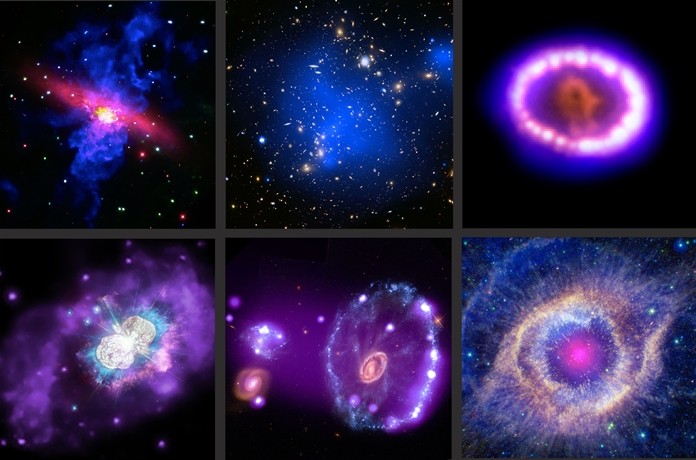
This
selection of images of different kinds of light from various missions
and telescopes have been combined to better understand the universe.
Each composite image contains X-ray data from Chandra as well as other
telescopes. The objects represent a range of different astrophysical
objects and include the galaxy Messier 82, the galaxy cluster Abell
2744, the supernova remnant 1987A, the binary star system Eta Carinae,
the Cartwheel galaxy, and the planetary nebula Helix Nebula. Credits:
NASA/CXC/SAO, NASA/STScI, NASA/JPL-Caltech/SSC, ESO/NAOJ/NRAO, NRAO/AUI/NSF,
NASA/CXC/SAO/PSU, and NASA/ESA
Molly Porter & Megan Watzke
Humanity has "eyes" that can detect all different
types of light through telescopes around the globe and a fleet of
observatories in space. From radio waves to gamma rays, this "multiwavelength"
approach to astronomy is crucial to getting a complete understanding of
objects in space.
This compilation gives examples of images from
different missions and telescopes being combined to better understand
the science of the universe. Each of these images contains data from
NASA's Chandra X-ray Observatory as well as other telescopes. Various
types of objects are shown (galaxies, supernova remnants, stars,
planetary nebulas), but together they demonstrate the possibilities when
data from across the electromagnetic spectrum are assembled.
Top row, from left to right:
Messier 82, or M82, galaxy
Credits: X-ray: NASA/CXC; Optical: NASA/STScI
Messier 82, or M82, is a galaxy that is oriented
edge-on to Earth. This gives astronomers and their telescopes an
interesting view of what happens as this galaxy undergoes bursts of star
formation. X-rays from Chandra (appearing as blue - up & down - and pink
- side to side) show gas in outflows about 20,000 light years long that
has been heated to temperatures above ten million degrees by repeated
supernova explosions. Optical light data from NASA's Hubble Space
Telescope (red and orange - center) shows the galaxy.
Galaxy cluster Abell 2744
Credits: NASA/CXC; Optical: NASA/STScI
Galaxy clusters are the largest objects in the
universe held together by gravity. They contain enormous amounts of
superheated gas, with temperatures of tens of millions of degrees, which
glows brightly in X-rays, and can be observed across millions of light
years between the galaxies. This image of the Abell 2744 galaxy cluster
combines X-rays from Chandra (diffuse blue emission) with optical light
data from Hubble (red, green, and blue).
Supernova 1987A (SN 87A).
Credits: Radio: ALMA (ESO/NAOJ/NRAO), P. Cigan and
R. Indebetouw; NRAO/AUI/NSF, B. Saxton; X-ray: NASA/CXC/SAO/PSU/K. Frank
et al.; Optical: NASA/STScI
On February 24, 1987, observers in the southern
hemisphere saw a new object in a nearby galaxy called the Large
Magellanic Cloud. This was one of the brightest supernova explosions in
centuries and soon became known as Supernova 1987A (SN 87A). The Chandra
data (blue – outer ring) show the location of the supernova's shock wave
— similar to the sonic boom from a supersonic plane — interacting with
the surrounding material about four light years from the original
explosion point. Optical data from Hubble (orange and red – inner rings)
also shows evidence for this interaction in the ring.
Bottom row, from left to right:
Eta Carinae
Credits: NASA/CXC; Ultraviolet/Optical: NASA/STScI;
Combined Image: NASA/ESA/N. Smith (University of Arizona), J. Morese (BoldlyGo
Instituts) and A. Pagan
What will be the next star in our Milky Way galaxy
to explode as a supernova? Astronomers aren't certain, but one candidate
is in Eta Carinae, a volatile system containing two massive stars that
closely orbit each other. This image has three types of light: optical
data from Hubble (appearing as white center), ultraviolet (cyan – small
band surrounding center) from Hubble, and X-rays from Chandra (appearing
as purple emission – outer band surrounding both). The previous
eruptions of this star have resulted in a ring of hot, X-ray emitting
gas about 2.3 light years in diameter surrounding these two stars.
The Cartwheel galaxy
Credits: X-ray: NASA/CXC; Optical: NASA/STScI
This galaxy resembles a bull's eye, which is
appropriate because its appearance is partly due to a smaller galaxy
that passed through the middle of this object. The violent collision
produced shock waves that swept through the galaxy and triggered large
amounts of star formation. X-rays from Chandra (purple) show disturbed
hot gas initially hosted by the Cartwheel galaxy being dragged over more
than 150,000 light years by the collision. Optical data from Hubble
(red, green, and blue) show where this collision may have triggered the
star formation.
The Helix nebula
Credits: X-ray: NASA/CXC; Ultraviolet:
NASA/JPL-Caltech/SSC; Optical: NASA/STScI (M. Meixner)/ESA/NRAO (T.A.
Rector); Infrared: NASA/JPL-Caltech/K. Su
When a star like the Sun runs out of fuel, it
expands and its outer layers puff off, and then the core of the star
shrinks. This phase is known as a "planetary nebula," and astronomers
expect our Sun will experience this in about 5 billion years. This Helix
Nebula image contains infrared data from NASA's Spitzer Space Telescope
(green and red), optical light from Hubble (orange and blue),
ultraviolet from NASA's Galaxy Evolution Explorer (cyan), and Chandra's
X-rays (appearing as white) showing the white dwarf star that formed in
the center of the nebula. The image is about four light years across.
Three of these images — SN 1987A, Eta Carinae, and
the Helix Nebula — were developed as part of NASA's Universe of Learning
(UoL), an integrated astrophysics learning and literacy program, and
specifically UoL's ViewSpace project. The UoL brings together experts
who work on Chandra, the Hubble Space Telescope, Spitzer Space
Telescope, and other NASA astrophysics missions.
NASA's Marshall Space Flight Center manages the
Chandra program. The Smithsonian Astrophysical Observatory's Chandra
X-ray Center controls science from Cambridge Massachusetts and flight
operations from Burlington, Massachusetts.
For more Chandra images, multimedia and related
materials, visit:
http://www.nasa.gov/chandra
|

|
Hubble provides holistic view of stars gone haywire
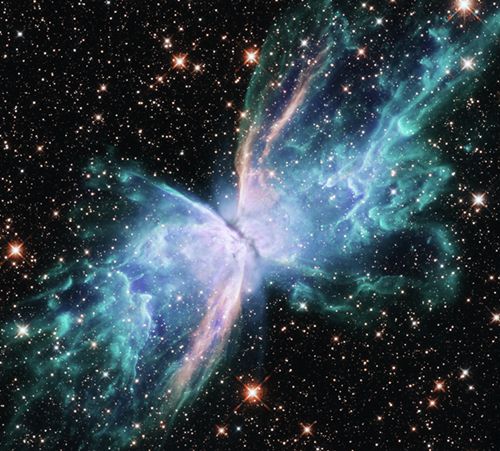
Hubble was recently retrained on NGC 6302,
known as the “Butterfly Nebula,” to observe it across a more complete
spectrum of light, from near-ultraviolet to near-infrared, helping
researchers better understand the mechanics at work in its technicolor
“wings” of gas. (Credits: NASA, ESA and J. Kastner (RIT))
NASA
As nuclear fusion engines, most
stars live placid lives for hundreds of millions to billions of years.
But near the end of their lives they can turn into crazy whirligigs,
puffing off shells and jets of hot gas. Astronomers have employed
Hubble’s full range of imaging capabilities to dissect such crazy
fireworks happening in two nearby young planetary nebulas. NGC 6302 is
dubbed the Butterfly Nebula because of its wing-like appearance. In
addition, NGC 7027 resembles a jewel bug, an insect with a brilliantly
colorful metallic shell.
The researchers have found
unprecedented levels of complexity and rapid changes in jets and gas
bubbles blasting off of the stars at the centers of both nebulas. Hubble
is allowing the researchers to converge on an understanding of the
mechanisms underlying the chaos.
“When I looked in the Hubble
archive and realized no one had observed these nebulas with Hubble’s
Wide Field Camera 3 across its full wavelength range, I was floored,”
said Joel Kastner of Rochester Institute of Technology, Rochester, New
York, leader of the new study. “These new multi-wavelength Hubble
observations provide the most comprehensive view to date of both of
these spectacular nebulas. As I was downloading the resulting images, I
felt like a kid in a candy store.”
By examining this pair of nebulas
with Hubble’s full, panchromatic capabilities — making observations in
near-ultraviolet to near-infrared light — the team has had several “aha”
moments. In particular, the new Hubble images reveal in vivid detail how
both nebulas are splitting themselves apart on extremely short
timescales — allowing astronomers to see changes over the past couple
decades. Some of this rapid change may be indirect evidence of one star
merging with its companion star.
“The nebula NGC 7027 shows emission
at an incredibly large number of different wavelengths, each of which
highlights not only a specific chemical element in the nebula, but also
the significant, ongoing changes in its structure,” said Kastner. The
research team also observed the Butterfly Nebula, which is a counterpart
to the “jewel bug” nebula: Both are among the dustiest planetary nebulas
known and both also contain unusually large masses of gas because they
are so newly formed. This makes them a very interesting pair to study in
parallel, say researchers.
Hubble’s broad multi-wavelength
views of each nebula are helping the researchers to trace the nebulas’
histories of shock waves. Such shocks typically are generated when
fresh, fast stellar winds slam into and sweep up more slowly expanding
gas and dust ejected by the star in its recent past, generating
bubble-like cavities with well-defined walls.
Researchers suspect that at the
hearts of both nebulas are — or were — two stars circling around each
other, like a pair of figure skaters. Evidence for such a central
“dynamic duo” comes from the bizarre shapes of these nebulas. Each has a
pinched, dusty waist and polar lobes or outflows, as well as other, more
complex symmetrical patterns.
A leading theory for the generation
of such structures in planetary nebulas is that the mass-losing star is
one of two stars in a binary system. The two stars orbit one another
closely enough that they eventually interact, producing a gas disk
around one or both stars. The disk is the source of outflowing material
directed in opposite directions from the central star.
Similarly, the smaller star of the
pair may merge with its bloated, more rapidly evolving stellar
companion. This also can create outflowing jets of material that may
wobble over time. This creates a symmetric pattern, perhaps like the one
that gives NGC 6302 its “butterfly” nickname. Such outflows are commonly
seen in planetary nebulas.
“The suspected companion stars in
NGC 6302 and NGC 7027 haven’t been directly detected because they are
next to, or perhaps have already been swallowed by, larger red giant
stars, a type of star that is hundreds to thousands of times brighter
than the Sun,” said team member Bruce Balick of the University of
Washington in Seattle. “The hypothesis of merging stars seems the best
and simplest explanation for the features seen in the most active and
symmetric planetary nebulas. It’s a powerful unifying concept, so far
without rival.”
The Butterfly Nebula
Imagine a lawn sprinkler spinning
wildly, tossing out two S-shaped streams. At first it appears chaotic,
but if you stare for a while, you can trace its patterns. The same
S-shape is present in the Butterfly Nebula, except in this case it is
not water in the air, but gas blown out at high speed by a star. And the
“S” only appears when captured by the Hubble camera filter that records
near-infrared emission from singly ionized iron atoms.
“The S-shape in the iron emission
from the Butterfly Nebula is a real eye-opener,” Kastner said. The
S-shape directly traces the most recent ejections from the central
region, since the collisions within the nebula are particularly violent
in these specific regions of NGC 6302. “This iron emission is a
sensitive tracer of energetic collisions between slower winds and fast
winds from the stars,” Balick explained. “It’s commonly observed in
supernova remnants and active galactic nuclei, and outflowing jets from
newborn stars, but is very rarely seen in planetary nebulas.”
“The fact that the iron emission is
only showing up along these opposing, off-center directions implies that
the source of the fast flows is wobbling over time, like a spinning top
that’s about to fall,” added Kastner. “That’s another tell-tale sign of
the presence of a disk, which directs the flow, and also a binary
companion.”
The ‘Jewel Bug’ Nebula
The planetary nebula NGC 7027 had
been slowly puffing away its mass in quiet, spherically symmetric or
perhaps spiral patterns for centuries — until relatively recently. “In
some respects, the changes within this nebula are even more dramatic
than those within the Butterfly,” Kastner said. “Something recently went
haywire at the very center, producing a new cloverleaf pattern, with
bullets of material shooting out in specific directions.”
The research team’s new images of
NGC 7027 show emission from singly ionized iron that closely resembles
observations made by NASA’s Chandra X-ray Observatory in 2000 and 2014
as part of earlier research by Kastner, team member Rodolfo Montez Jr.
of the Center for Astrophysics | Harvard & Smithsonian, and
collaborators. The iron emission traces the
southeast-to-northwest-oriented outflows that also produce the
X-ray-emitting shocks imaged by Chandra. “We have a sneaking suspicion
that this nebula is a great example of what happens when a red giant
star abruptly swallows a companion,” Montez Jr. said.

Recently, NGC 7027’s central star was identified in a new wavelength of
light — near-ultraviolet — for the first time by using Hubble’s unique
capabilities. This object, which resembles a colorful jewel bug, is a
visibly diffuse region of gas and dust that may be the result of
ejections by closely orbiting binary stars that were first slowly
sloughing off material over thousands of years, and then entered a phase
of more violent and highly directed mass ejections. (Credits: NASA, ESA
and J. Kastner (RIT))
|

|
NASA astronauts launch from America in historic test flight of SpaceX Crew Dragon
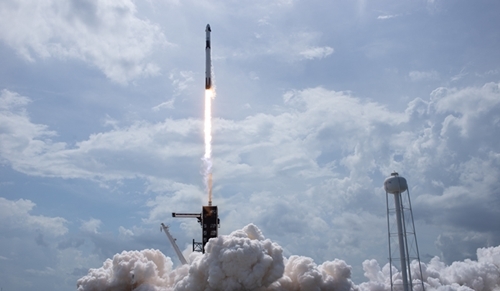
A SpaceX
Falcon 9 rocket carrying the company’s Crew Dragon spacecraft launches
from Launch Complex 39A on NASA’s SpaceX Demo-2 mission to the
International Space Station with NASA astronauts Robert Behnken and
Douglas Hurley onboard, Saturday, May 30, 2020, at NASA’s Kennedy Space
Center in Florida.
NASA
For the first time in history, NASA
astronauts have launched from American soil in a commercially built and
operated American crew spacecraft on its way to the International Space
Station. The SpaceX Crew Dragon spacecraft carrying NASA astronauts
Robert Behnken and Douglas Hurley lifted off at 3:22 p.m. EDT Saturday,
May 30, on the company’s Falcon 9 rocket from Launch Complex 39A at
NASA’s Kennedy Space Center in Florida.
“Today a new era in human
spaceflight begins as we once again launched American astronauts on
American rockets from American soil on their way to the International
Space Station, our national lab orbiting Earth,” said NASA Administrator
Jim Bridenstine.
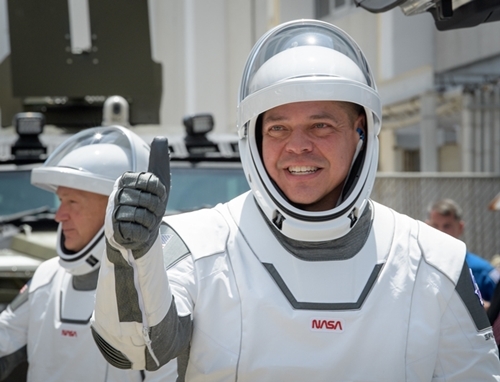
NASA
astronauts Robert Behnken, foreground, and Douglas Hurley, wearing
SpaceX spacesuits, are seen as they depart the Neil A. Armstrong
Operations and Checkout Building.
“I thank and congratulate Bob
Behnken, Doug Hurley, and the SpaceX and NASA teams for this significant
achievement for the United States. The launch of this commercial space
system designed for humans is a phenomenal demonstration of American
excellence and is an important step on our path to expand human
exploration to the Moon and Mars.”
Known as NASA’s SpaceX Demo-2, the
mission is an end-to-end test flight to validate the SpaceX crew
transportation system, including launch, in-orbit, docking and landing
operations. This is SpaceX’s second spaceflight test of its Crew Dragon
and its first test with astronauts aboard, which will pave the way for
its certification for regular crew flights to the station as part of
NASA’s Commercial Crew Program.
“This is a dream come true for me
and everyone at SpaceX,” said Elon Musk, chief engineer at SpaceX. “It
is the culmination of an incredible amount of work by the SpaceX team,
by NASA and by a number of other partners in the process of making this
happen. You can look at this as the results of a hundred thousand people
roughly when you add up all the suppliers and everyone working
incredibly hard to make this day happen.”
The program demonstrates NASA’s
commitment to investing in commercial companies through public-private
partnerships and builds on the success of American companies, including
SpaceX, already delivering cargo to the space station.
“It’s difficult to put into words
how proud I am of the people who got us here today,” said Kathy Lueders,
NASA’s Commercial Crew Program manager. “When I think about all of the
challenges overcome – from design and testing, to paper reviews, to
working from home during a pandemic and balancing family demands with
this critical mission – I am simply amazed at what the NASA and SpaceX
teams have accomplished together. This is just the beginning; I will be
watching with great anticipation ... through every phase of this
historic mission.”
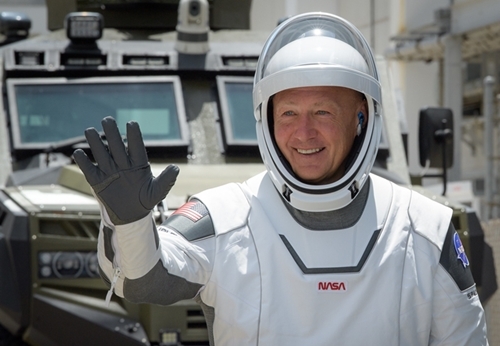
NASA
astronaut Douglas Hurley waves as he and fellow crew member Robert
Behnken depart the Neil A. Armstrong Operations and Checkout Building
for Launch Complex 39A to board the SpaceX Crew Dragon spacecraft for
the Demo-2 mission launch, Saturday, May 30, 2020, at NASA’s Kennedy
Space Center in Florida.
SpaceX controlled the launch of the
Falcon 9 rocket from Kennedy’s Launch Control Center Firing Room 4, the
former space shuttle control room, which SpaceX has leased as its
primary launch control center. As Crew Dragon ascended into space,
SpaceX commanded the spacecraft from its mission control center in
Hawthorne, California. NASA teams are monitoring space station
operations throughout the flight from Mission Control Center at the
agency’s Johnson Space Center in Houston.
The SpaceX Crew Dragon spacecraft
docked to the space station at 10:29 a.m. Sunday, May 31. Behnken and
Hurley will work with SpaceX mission control to verify the spacecraft is
performing as intended by testing the environmental control system, the
displays and control system, and by maneuvering the thrusters, among
other things.
The first docking maneuver began
Saturday, May 30, at 4:09 p.m., and the spacecraft began its close
approach to the station at about 8:27 a.m. Sunday, May 31. Crew Dragon
is designed to dock autonomously, but the crews onboard the spacecraft
and the space station diligently monitor the performance of the
spacecraft as it approaches and docks to the forward port of the
station’s Harmony module.
After successfully docking, the
crew were welcomed aboard the International Space Station, where they
became members of the Expedition 63 crew, which currently includes NASA
astronaut Chris Cassidy. The crew will perform tests on Crew Dragon in
addition to conducting research and other tasks with the space station
crew.
Demo-2 Astronauts
Behnken is the joint operations
commander for the mission, responsible for activities such as
rendezvous, docking and undocking, as well as Demo-2 activities while
the spacecraft is docked to the space station. He was selected as a NASA
astronaut in 2000 and has completed two space shuttle flights. Behnken
flew STS-123 in March 2008 and STS-130 in February 2010, performing
three spacewalks during each mission.
Hurley is the spacecraft commander
for Demo-2, responsible for activities such as launch, landing and
recovery. He was selected as an astronaut in 2000 and has completed two
spaceflights. Hurley served as pilot and lead robotics operator for both
STS127 in July 2009 and STS135, the final space shuttle mission, in July
2011.
Mission Objectives
The Demo-2 mission is the final
major test before NASA’s Commercial Crew Program certifies Crew Dragon
for operational, long-duration missions to the space station. As
SpaceX’s final flight test, it will validate all aspects of its crew
transportation system, including the Crew Dragon spacecraft, spacesuits,
Falcon 9 launch vehicle, launch pad 39A and operations capabilities.
While en route to the station,
Behnken and Hurley took control of Crew Dragon for two manual flight
tests, demonstrating their ability to control the spacecraft should an
issue with the spacecraft’s automated flight arise. On Saturday, May 30,
while the spacecraft coasted, the crew tested its roll, pitch and yaw.
When Crew Dragon was about 1 kilometer (0.6 miles) below the station and
moving around to the docking axis, the crew conducted manual in-orbit
demonstrations of the control system in the event it were needed. After
pausing, rendezvous resumed and mission managers made a final decision
about whether to proceed to docking as Crew Dragon approached 20 meters
(66 feet).
For operational missions, Crew
Dragon will be able to launch as many as four crew members at a time and
carry more than 220 pounds of cargo, allowing for an increased number
crew members aboard the space station and increasing the time dedicated
to research in the unique microgravity environment, as well as returning
more science back to Earth.
The Crew Dragon being used for this
flight test can stay in orbit about 110 days, and the specific mission
duration will be determined once on station based on the readiness of
the next commercial crew launch. The operational Crew Dragon spacecraft
will be capable of staying in orbit for at least 210 days as a NASA
requirement.
At the conclusion of the mission,
Behnken and Hurley will board Crew Dragon, which will then autonomously
undock, depart the space station, and re-enter Earth’s atmosphere. Upon
splashdown off Florida’s Atlantic coast, the crew will be picked up by
the SpaceX recovery ship and returned to the dock at Cape Canaveral.
NASA’s Commercial Crew Program is
working with SpaceX and Boeing to design, build, test and operate safe,
reliable and cost-effective human transportation systems to low-Earth
orbit. Both companies are focused on test missions, including abort
system demonstrations and crew flight tests, ahead of regularly flying
crew missions to the space station. Both companies’ crewed flights will
be the first times in history NASA has sent astronauts to space on
systems owned, built, tested and operated by private companies.
Learn more about NASA’s Commercial
Crew program at:
https://www.nasa.gov/commercialcrew
(Photo Credits: NASA/Bill
Ingalls)
|

|
NASA Science keeps the lights on
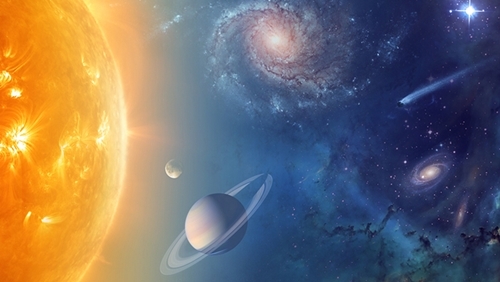
Across NASA’s many
missions, thousands of scientists, engineers, and other experts and
professionals all over the country are doing what they do best, but now
from home offices and via video conferencing. With most personnel
supporting missions remotely to keep onsite staff at a minimal level in
response to COVID-19, the Agency is moving ahead strongly with
everything from space exploration to using our technology and innovation
to help inform policy makers.
NASA is studying whether there are
long-term responses from our planet caused by changes in human activity
patterns due to COVID-19 quarantines. In the short-term, our satellites
provide objective, accurate, and timely information on national and
global food supplies that will help support USDA, USAID, and the global
agencies that oversee food security. Scientists can track air quality
changes, such as the drop in nitrogen dioxide, a major air pollutant,
over major metropolitan areas around the world. Seeing Earth’s lights at
night also helps researchers track patterns in energy use and human
activity around the planet.
Responding to the White House’s
call to action to develop new technology and data mining approaches that
could help the research community address COVID-19 science questions,
NASA’s Jet Propulsion Laboratory (JPL) in California used artificial
intelligence and natural language technologies to extract medical
diagnoses, medical conditions, and drug and disease information from a
database of 25,000+ publications. The information helps shed light on
transmission, incubation, and environmental stability of the virus; what
has been published about medical care for those affected; what we know
about COVID-19 risk factors; and what we know about non-pharmaceutical
interventions. The data was made available to the research community on
March 23.
NASA’s Ames Research Center in
California’s Silicon Valley, will use its supercomputer to crunch
extremely complex and high volumes of data to help with COVID-19. The
center’s supercomputers are part of the White House’s COVID-19 High
Performance Computing Consortium to provide COVID-19 researchers with
access to the world’s most powerful high-performance computing resources
that can significantly advance the pace of scientific discovery in the
fight to stop the virus. The sophisticated computing can process massive
numbers of calculations related to bioinformatics, epidemiology and
molecular modeling, helping scientists develop answers to complex
scientific questions about COVID-19 in hours or days versus weeks or
months. To aid in the COVID-19 response, NASA is opening access to the
full portion of its supercomputing resources reserved for national
priorities outside of the agency’s aeronautics and space research and
exploration scope. This includes storage and providing support to help
researchers to port their applications to NASA computing systems, run
their applications, troubleshoot any issues and address any other
requested support, including visualization.
NASA is exploring additional ways
to leverage its expertise and capabilities to help with the national
COVID-19 response. Employees can submit ideas for solutions relevant to
COVID-19 via an internal crowdsourcing website. The call for ideas
focuses on urgent needs related to personal protective equipment,
ventilation devices, and monitoring and forecasting the spread and
impacts of the virus, but any idea is welcome. Multiple ideas may be
selected for follow-up and potential action.
While we leverage our technical
expertise and technology to help provide important COVID-19 information,
we continue our exploration of the solar system and beyond.
The interagency Community
Coordinated Modeling Center continues to support and protect NASA
robotic missions by monitoring space weather. We’re also monitoring the
sun 24 hours a day, seven days a week with our missions like the Solar
Dynamics Observatory and the Solar Terrestrial Relations Observatory.
We’re also keeping an eye on asteroids, detecting and characterizing
near-earth objects zooming by.
For asteroids much farther out,
OSIRIS-REx is gearing up for its close approach of Bennu on April 14,
using Natural Feature Tracking (NFT) optical navigation flying to a
range of about 125 meters from the surface, followed by the final
low-altitude (about 250 meter) reconnaissance flyover of the backup
Osprey sample site on May 26.
Recently, the Mars Curiosity
science team conducted its first “drilling while teleworking” activity.
The team, while working remotely, controlled the rover in digging a hole
in “Edinburgh,” a target on the top of the Greenheugh Pediment to learn
more about the capping material that was a layer covering a large
portion of Gail crater but now only remains in a few places.
Juno’s next close flyby of Jupiter
is slated for April 10 with the spacecraft at a specially designed
attitude to increase particle measurements over the planet’s aurora.
During this close flyby, known as PJ-26, or Perijove-26, scientists hope
they will get measurements to help answer key questions about how
Jupiter’s aurora work and compare with Earth’s aurora.
With Hubble reaching its 30th year
in space on April 24, the team is about to kick off the annual peer
review of science proposals competing for Hubble observing time in the
coming year. While the review usually involves astronomers all over the
world gathering at the Space Telescope Science Institute in Baltimore,
this review will be held via videoconference. NASA’s other operating
Great Observatory, Chandra, continues to study objects across the
universe. In the last few weeks, the observatory has collected X-ray
data on Supernova 1987A and a developing galaxy cluster 10 billion light
years away, among many other targets. Chandra also will soon observe a
possible magnetar, a neutron star with an extraordinarily strong
magnetic field, discovered on March 10th. Chandra’s annual peer review
will be held in June with participants joining remotely. The James Webb
Space Telescope will continue its integration and testing at Northrop
Grumman in California with a reduced staff until Deployable Tower
Assembly set up in April.
Science data continues to roll in
from the International Space Station, including from NICER, with the
instrument maintaining its twice a week target plans. The NICER
operation team is taking target of opportunity requests from the
community. A few of the highlights over the past two weeks include the
detection of a glitch in a magnetar that NICER discovered three weeks
ago and the discovery that a recent X-ray transient is actually a
neutron star binary system with eclipses. In addition, NICER has just
begun its second Guest Observer Cycle where it is providing data to
outside teams that won competitively selected time.
Although health advisories have
grounded NASA’s airborne Earth Science research campaigns temporarily,
its 15 Earth-observing satellite missions and six instruments on the
International Space Station are operating without disruption, tracking
the natural and human-driven changes of our home planet, as well as
beginning to gather data on variations resulting from human activity
responding to COVID-19.
We continue to publish important
research, such as a report released March 23 on the rate of retreat and
shape of the ground underneath the Denman Glacier in East Antarctica.
Scientists at JPL and the University of California, Irvine, analyzed
radar data from four satellites from the Italian COSMO-SkyMed mission
and found that the shape of ground beneath the ice sheet allows warm
ocean water to flow underneath, leading to quicker and irreversible
retreat and resulting in subsequent sea level rise.
NASA’s space biology research
continues to study the basic workings of the human body and model
organism analogs. Scientists are studying immune systems, bones,
muscles, hearts – and even how our bodies interact with microorganisms
in the unique environment of space. By studying how organisms respond to
microgravity and other aspects of space, we increase our understanding
of life on Earth and develop the knowledge needed to support long-term
human habitation in space. This fundamental research is turning into
better treatments for patients here on Earth. Platforms like NASA’s
Rodent Research fly regularly to the International Space Station with
commercial and academic experiments involving novel medicines and bone
and muscle research.
In addition to continuing
spacecraft operations, science data analysis continues across our
missions, with significant publishing activity from NASA-funded
researchers. Our researchers collect and analyze data and collaborate
with the interagency and international research community to address all
aspects of NASA science. All data products are open and freely available
via our network of online data centers and websites. Submitted research
grant proposals and mission selections are being evaluated, chosen, and
announced, with the agency stepping up to address online proposal
submissions in the time of COVID-19 challenges.
From remote controlling spacecraft
and gathering data, to managing mission operations and conducting
research, NASA will keep working for the nation while protecting the
health and safety of our workforce.
|

|
NASA outlines lunar surface sustainability concept
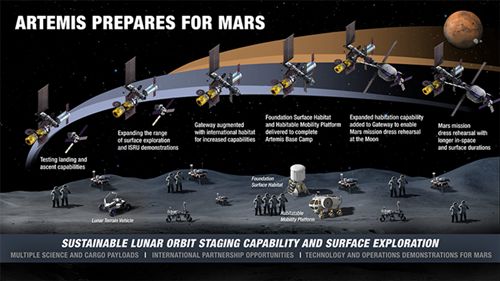
Infographic showing the evolution of lunar
activities on the surface and in orbit.
When NASA sends astronauts to the
surface of the Moon in 2024, it will be the first time outside of
watching historical footage most people witness humans walking on
another planetary body. Building on these footsteps, future robotic and
human explorers will put in place infrastructure for a long-term
sustainable presence on the Moon.
NASA recently proposed a plan to go
from limited, short-term Apollo-era exploration of the 1960s, to a 21st
Century plan in a report to the National Space Council. With the Artemis
program, we will explore more of the Moon than ever before to make the
next giant leap – sending astronauts to Mars.
“After 20 years of continuously
living in low-Earth orbit, we’re now ready for the next great challenge
of space exploration – the development of a sustained presence on and
around the Moon,” said NASA Administrator Jim Bridenstine. “For years to
come, Artemis will serve as our North Star as we continue to work toward
even greater exploration of the Moon, where we will demonstrate key
elements needed for the first human mission to Mars.”
On the surface, the core elements
for a sustained presence would include an emphasis on mobility to allow
astronauts to explore more of the Moon and conduct more science:
* A lunar terrain vehicle or LTV,
would transport crew around the landing zone.
* The habitable mobility platform
would enable crews to take trips across the Moon lasting up to 45 days.
* A lunar foundation surface
habitat would house as many as four crew members on shorter surface
stays.
Astronauts working on the lunar
surface also could test advanced robotics, as well as a wide set of new
technologies identified in the Lunar Surface Innovation Initiative,
focusing on tech development in the areas such as of in-situ resource
utilization (ISRU) and power systems. Rovers will carry a variety of
instruments including ISRU experiments that will generate information on
the availability and extraction of usable resources (e.g., oxygen and
water). Advancing these technologies could enable the production of
fuel, water, and/or oxygen from local materials, enabling sustainable
surface operations with decreasing supply needs from Earth.
Another key difference from Apollo
and Artemis will be use of the Gateway in lunar orbit, built with
commercial and international partners. The lunar outpost will serve as a
command and control module for surface expeditions and an office and
home for astronauts away from Earth. Operating autonomously when crew is
not present, it also will be a platform for new science and technology
demonstrations around the Moon.
Over time, NASA and its partners
will enhance the lunar Gateway’s habitation capabilities and related
life support systems. Adding a large-volume deep space habitation
element would allow astronauts to test capabilities around the Moon for
long-duration deep space missions.
While the goal of Apollo was to
land the first humans on the Moon, the Artemis program will use the Moon
as a testbed for crewed exploration farther into the solar system,
beginning with Mars. This is America’s Moon to Mars space exploration
approach. A proposed multi-month split-crew operation at the Gateway and
on the lunar surface would test the agency’s concept for a human mission
to the Red Planet.
For such a mission, NASA envisions
a four-person crew traveling to the Gateway and living aboard the
outpost for a multi-month stay to simulate the outbound trip to Mars.
Later, two crew members would travel to the lunar surface and explore
with the habitable mobility platform, while the remaining two astronauts
stay aboard Gateway. The four crew members are later reunited aboard the
lunar outpost for another multi-month stay, simulating the return trip
to Earth. This mission would be the longest duration human deep space
mission in history and would be the first operational test of the
readiness of our deep-space systems.
< | 
